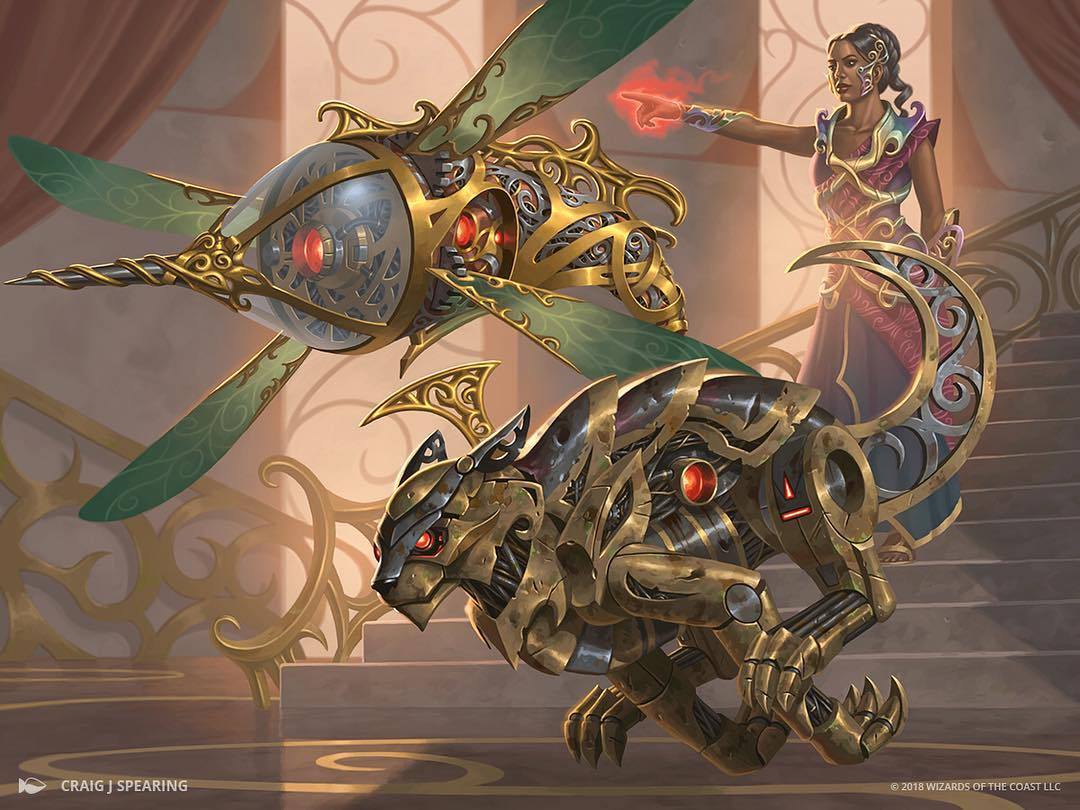Are you a Quiet Speculation member?
If not, now is a perfect time to join up! Our powerful tools, breaking-news analysis, and exclusive Discord channel will make sure you stay up to date and ahead of the curve.
This past week I got an invite from TCGplayer to turn my store into a Direct store. I had only once received a similar email, during the early stages of the Pandemic when the major retailers closed and my online sales spiked hard. Previously, there were pretty stringent requirements to be invited into the Direct program. The site currently shows the following requirements:
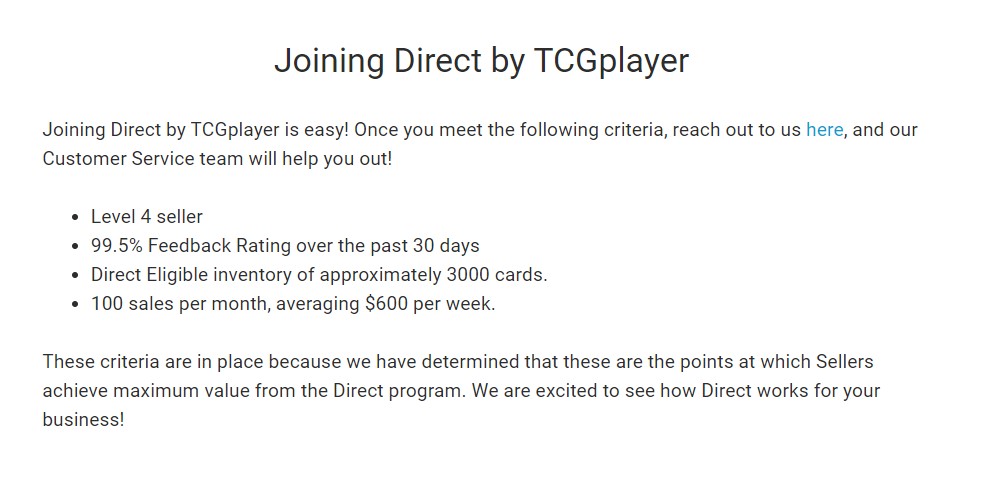
Interestingly, my store does not meet the requirements. I am not close to 100 sales per month nor do I have an inventory of 3000 cards listed. This implies that they may be changing or updating those requirements.
Still, I got the email and it's something I wanted to dig into. As a small-time seller, I don't have to devote a lot of time each day to packaging and selling cards. I have a limited inventory of around 2000 cards and throughout my store's existence, I have probably averaged somewhere between 1-5 sales per day. Thus, this is not something that eats into my free time enough to make me want to immediately jump on board.
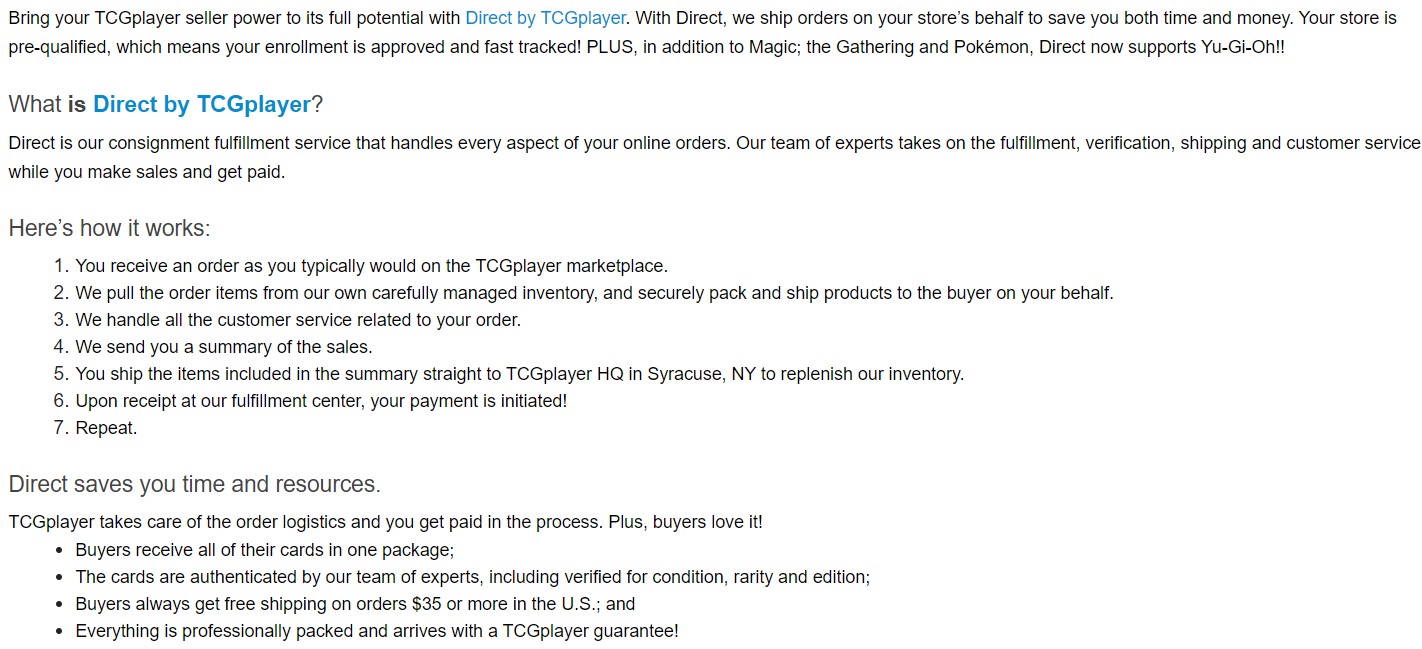
Fee Comparison
As a business, my goal is to maximize my profit, so logically the first step in our decision-making process is to compare the fee structures. The chart below is their fee breakdown.
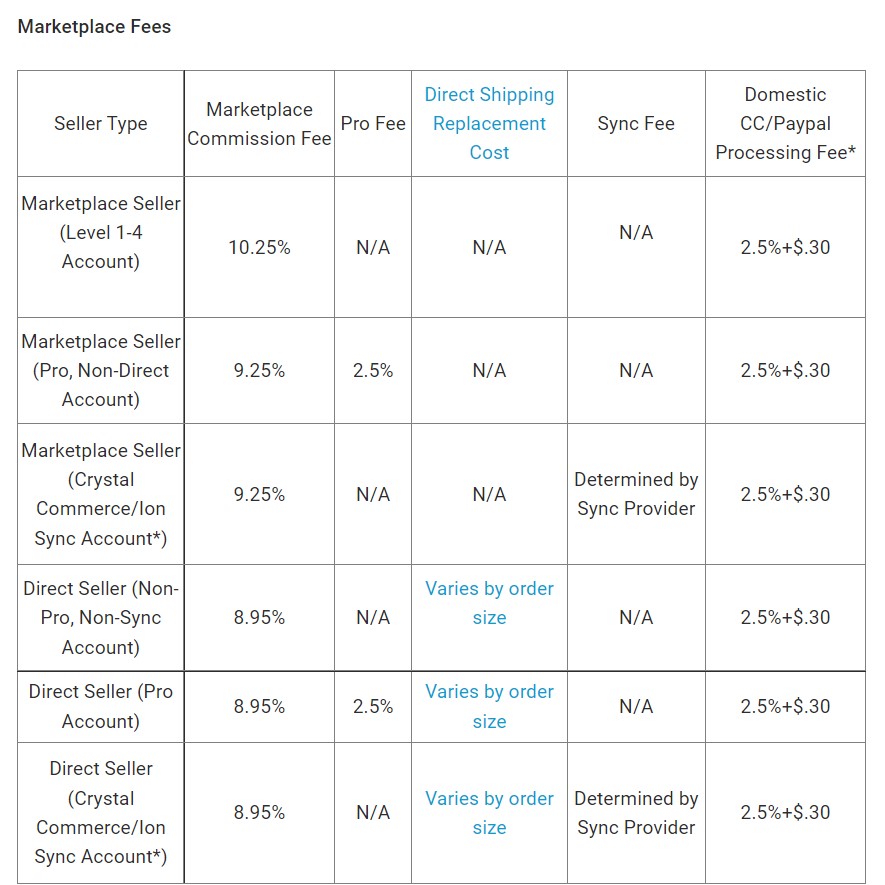
Obviously, the last bit of information we need is the Direct Replacement Shipping Cost breakdown.
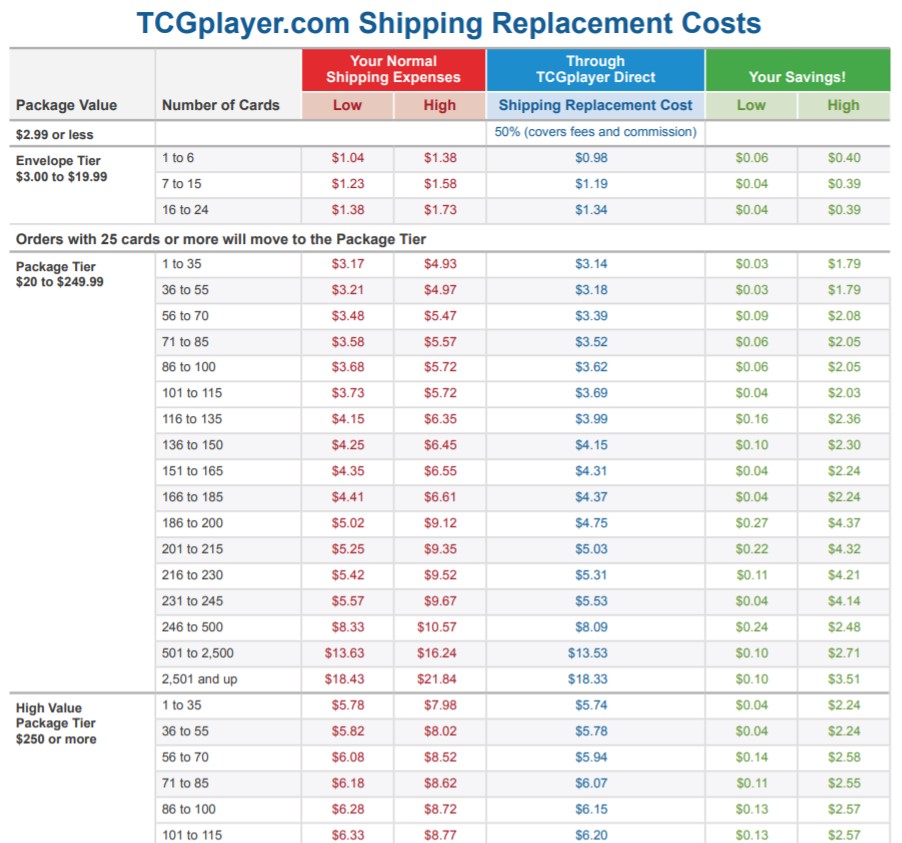
Real-Life Examples
I realize that's a lot to take in so we will do some quick examples to help make sense of it all. Here are 4 of my more recent sales fully broken down (keep in mind, I am NOT currently a direct seller).
| Card Name | Qty | Sale Price ($) | TCGPlayer Shipping Cost ($) | TCGPlayer Fee Amount ($) | TCGPlayer Net Total ($) | Actual Shipping ($) | Final Take Home ($) |
| Dowsing Dagger | 1 | $3.25 | $1.15 | $0.87 | $3.53 | $0.50 | $3.03 |
| Kruin Outlaw | 1 | $4.00 | $1.15 | $0.97 | $4.18 | $0.50 | $3.68 |
| Torpor Orb | 3 | $59.97 | $1.15 | $8.22 | $52.90 | $3.75 | $49.15 |
| Sudden Spoiling | 1 | $2.99 | $1.15 | $0.84 | $3.30 | $0.50 | $2.80 |
The last column is arguably the most important, as it is my final "take-home" from each sale. Now let's look at those sales as if they were made using Direct, using the above tables for our calculations.
| Card Name | Qty | Sale Price ($) | Estimated Direct Fee Amount ($) | TCGplayer Replacement Shipping ($) | Final Take Home ($) |
| Dowsing Dagger | 1 | $3.25 | $0.67 | $0.98 | $1.60 |
| Kruin Outlaw | 1 | $4.00 | $0.76 | $0.98 | $2.26 |
| Torpor Orb | 3 | $59.97 | $7.17 | $3.14 | $49.66 |
| Sudden Spoiling | 1 | $2.99 | $0.64 | $0.98 | $1.37 |
Comparing the two options, the only time I come out better with Direct is on the larger more expensive orders. One of the biggest factors in this "Final Take Home" difference is the fact that non-Direct sellers get to have their shipping cost added to the order, whereas, Direct sellers never see a dime of the shipping cost.
However, if this were all that was involved you would likely see very few Direct sellers.
Why Bother then?
You are likely asking yourself why bother with Direct at all if you're far more likely to make less money per sale. There are two additional factors to take into account. One may be somewhat obvious for those who often buy from Direct sellers on TCGplayer. Direct sellers tend to price their cards higher than TCGLow, where many of us have to price our cards to sell them. Below is a random sampling of a list of cards I came up with, in which I compared the lowest-priced TCGplayer Non-Direct option versus the lowest priced Direct TCGplayer option. I eliminated options that were not at least LP in condition, and I added in the shipping cost for the non-direct option.
| Card Name | Lowest Cost Option | Lowest Cost Direct Option | Direct “Surcharge” Percent |
| Goldspan Dragon | $27.29 | $35.84 | 23.86% |
| Karn, Scion of Urza | $7.25 | $8.39 | 13.59% |
| Teferi, Hero of Dominaria | $22.99 | $24.61 | 6.58% |
| Torpor Orb | $16.97 | $25.50 | 33.45% |
| Inspiring Statuary | $4.63 | $5.46 | 15.20% |
| Snapcaster Mage | $40.99 | $45.33 | 9.57% |
| Urza's Saga | $22.99 | $27.03 | 14.95% |
| Esper Sentinel | $16.99 | $18.99 | 10.53% |
| Flooded Strand | $32.99 | $39.89 | 17.30% |
| Alrund's Epiphany | $9.49 | $9.99 | 5.01% |
| Wrenn and Seven | $15.25 | $19.59 | 22.15% |
| Memory Deluge | $5.49 | $6.94 | 20.89% |
| Craterhoof Behemoth | $39.99 | $42.28 | 5.42% |
| Rhystic Study | $27.99 | $33.85 | 17.31% |
| Breeding Pool | $18.59 | $21.83 | 14.84% |
| Hallowed Fountain | $7.70 | $9.00 | 14.44% |
While this is obviously a small sample size, I think it's fair to assume that the true "Direct Surcharge" likely falls in the 15-20% range, with this sample average 15.32%. This implies you can likely sell your cards for around 15-20% more per card by using the TCGplayer Direct platform.
The second factor is sales volume. I talked to several Direct store owners and the overall consensus is that you are likely to see somewhere between 2x and 4x your current sales volume switching to Direct. So you may make less per sale, but if you get a lot more sales your overall income may go up.
Dead Zones
I would like to thank one of our QS members who were invaluable to the writing of this article, biospark88, who runs a Direct store, and who provided a good bit of insight on the matter. One key point he mentioned was the "dead zones," which can be especially bad for Direct sellers. To begin though, it is critical to keep in mind that for non-direct, TCGplayer recommends tracking on all orders above $20; but does not require it. Tracking is only required on orders above $50. For this reason, you often see a lot of $51 cards going for $49.99 or some other amount below $50, as it costs around $3.75 to ship a tracked bubble mailer, whereas it costs only around $0.6 to send a plain white envelope. Thus, there are certain price ranges that cause you as a seller to come out worse by charging more. This is especially true with TCGplayer Direct, as they triple the "shipping replacement" fee between $19.99 and $20. Thus, you will rarely see TCGplayer Direct cards priced anywhere between $20-$24.
On a similar note, you'll see that on everything under $2.99, you only get 50% in the end. This can still be great for bulk cards that you are unlikely to ever sell regularly, as getting even $0.05 on a true bulk common or uncommon is great.
Final Comparison Chart
After all this research, I still need to decide whether I want to go Direct or not. This next chart is a direct comparison chart that includes a 20% "Direct Surcharge" to help make my decisions easier.
| TCGLow Value | TCGplayer Fees (ignoring sales tax) | Total Profit | TCGplayer Direct Price | TCGplayer Direct Fees | Direct Total Profit |
| $1.00 | $0.43 | $1.72 | $1.20 | $0.60 | $0.60 |
| $1.50 | $0.49 | $2.16 | $1.80 | $0.90 | $0.90 |
| $2.00 | $0.56 | $2.60 | $2.40 | $1.20 | $1.20 |
| $2.50 | $0.62 | $3.03 | $3.00 | $1.62 | $1.38 |
| $3.00 | $0.68 | $3.47 | $3.60 | $2.54 | $1.06 |
| $3.50 | $0.75 | $3.90 | $4.20 | $1.66 | $2.54 |
| $4.00 | $0.81 | $4.34 | $4.80 | $1.53 | $3.27 |
| $4.50 | $0.87 | $4.78 | $5.40 | $1.60 | $3.80 |
| $5.00 | $0.94 | $5.21 | $6.00 | $2.65 | $3.35 |
| $5.50 | $1.00 | $5.65 | $6.60 | $4.88 | $1.72 |
| $6.00 | $1.07 | $6.09 | $7.20 | $1.80 | $5.40 |
| $6.50 | $1.13 | $6.52 | $7.80 | $2.37 | $5.43 |
| $7.00 | $1.19 | $6.96 | $8.40 | $1.94 | $6.46 |
| $7.50 | $1.26 | $7.39 | $9.00 | $2.10 | $6.90 |
| $8.00 | $1.32 | $7.83 | $9.60 | $2.08 | $7.52 |
| $8.50 | $1.38 | $8.27 | $10.20 | $2.15 | $8.05 |
| $9.00 | $1.45 | $8.70 | $10.80 | $2.22 | $8.58 |
| $9.50 | $1.51 | $9.14 | $11.40 | $2.29 | $9.11 |
| $10.00 | $1.58 | $9.58 | $12.00 | $2.35 | $9.65 |
The key here is that the Direct option is likely better for those whose sales are often above $10 TCGLow. Once a sale gets past $10 TCGLow, you come out ahead using Direct.
So lastly, I need to determine what the value of my average sales is. Luckily, I track my sales in a spreadsheet so I can easily find that my averages over the last 3 years are; 2021-$10.63, 2020- $7.62, 2019- $11.63. So 2 of the last 3 years are above $10 per average sale. However, digging a bit deeper than the overall average, if I eliminate just the top 10 high dollar sales from each year, my overall average falls well below $10 in all 3 years. Thus, for the time being, I will not be moving to Direct. The reason I did this was to eliminate a couple of potential outliers from skewing the data too highly, which the results indicate they did.
Conclusion
While my final verdict was to stick to maintaining my regular non-Direct TCGplayer storefront, the circumstances for each individual will vary and I suggest you follow my logical path with your own data to make your final decision.


